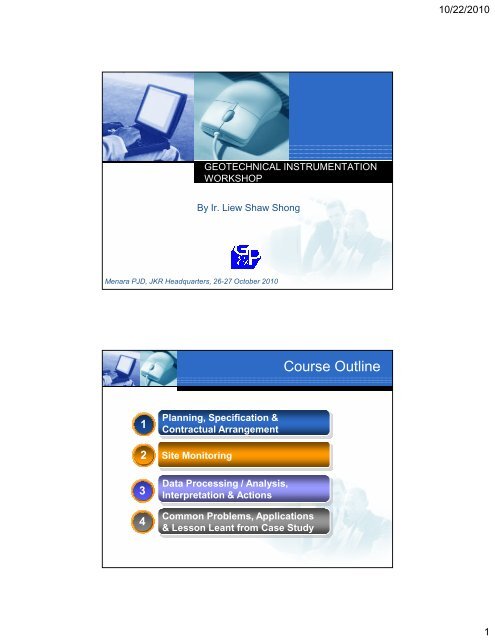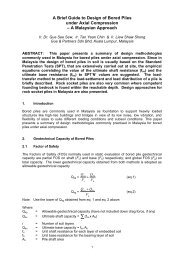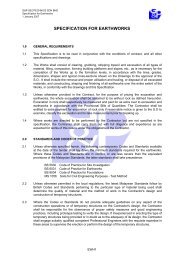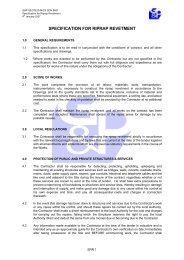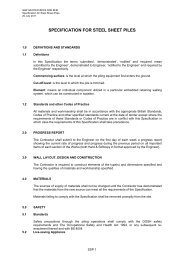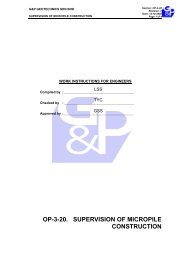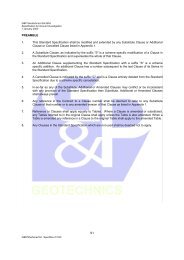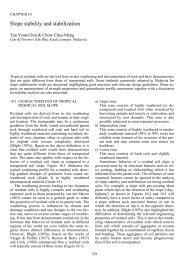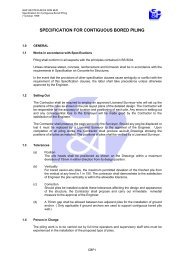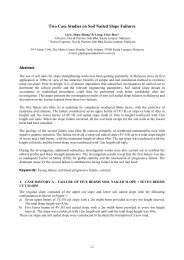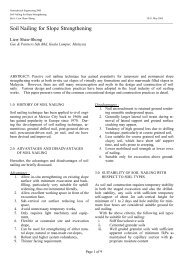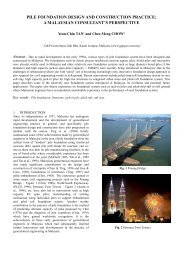GEOTECHNICAL INSTRUMENTATION ... - Gnpgeo.com.my
GEOTECHNICAL INSTRUMENTATION ... - Gnpgeo.com.my
GEOTECHNICAL INSTRUMENTATION ... - Gnpgeo.com.my
Create successful ePaper yourself
Turn your PDF publications into a flip-book with our unique Google optimized e-Paper software.
10/22/2010<strong>GEOTECHNICAL</strong> <strong>INSTRUMENTATION</strong>WORKSHOPBy Ir. Liew Shaw ShongCompanyLOGOMenara PJD, JKR Headquarters, 26-27 October 2010Course Outline1234Planning, Specification &Contractual ArrangementSite MonitoringData Processing / Analysis,Interpretation & ActionsCommon Problems, Applications& Lesson Leant from Case Study1
10/22/2010Geotechnical Engineer大 地 工 程 師Civil Engineer岩 土 工 程 师GeotechnicalEngineerGeotechnical engineer in Malaysiais ambiguously regarded as“Geologist” in the public perception.Geotechnical engineer is a qualifiedcivil engineer registered with Boardof Engineers Malaysia as eithergraduate engineer or professionalengineer having relevant and<strong>com</strong>petent experience ingeotechnical works ability to plan ground investigation &characterise ground conditions forengineering processes identify & assess the potential geohazardsand the possible groundborne interaction to proposedstructures offer feasible engineering designsolutions to ensure safety &satisfactory performance of the endproduct of the engineering worksincluding its surrounding 3Why appoint GeotechnicalEngineer?Why Geotechnical Engineer?Geotechnical engineer as anunderwriter for risk assessment.GI as tools for GeotechnicalEngineerIt is regard as necessary, but not arewarding expense. (Uncertainty,sufficiently accurate design optionsfor Cost & Benefit study)What Risk in Ground & itsConsequence ?Ground Variability & Geo-hazards.Financial Viability & Cost Overrun(Construction & Operation).42
10/22/2010Risk AssessmentRisk Evaluationwith Cost-Benefit AnalysisRisk Mitigation(Pro-active)Risk Reduction(Defensive)Risk Avoidance563
10/22/2010Geology<strong>com</strong>positionHydrology genesisSurface fluid flow processeshydrologyStructural Mechanicsdeformationfailuremember designContinuum MechanicselasticityplasticityidealisationNumerical Analysisboundary elementfinite differencediscrete elementfinite elementGeochemistrywasteleachatesdurabilityModified from Morgenstern (2000)Structural SupportSystemse.g. foundationsFluid Control Systemse.g. damsUndergroundGeo-structurese.g. tunnelGeotechnical EngineeringSurface Geo-structurese.g. embankments, landfillsMaterialstypespropertiesgeosyntheticsRock MechanicsdeformationfailureseepageSite Explorationreconnaissancedrillingin-situ testinglaboratory testinggeophysicsSoil MechanicsdeformationfailureseepageGround Improvemente.g. densification,remediationGroundMovementsearthquakeliquefactionsinkholeFractureMechanicsblastingquarryMechanical EngineeringdrillinginstrumentexcavationConstructionpracticeexperiencePublic Policycodesstandardlaws & <strong>com</strong>plianceContract LawspecificationRisk Managementobservation methodrisk assessmentinstrumentation7Genesis/GeologyBurland’sGeotechnicalTriangleMorgenstern (2000)GroundProfilePrecedent,Empiricism,Experience,Risk-managementSite investigationGround descriptionGroundBehaviourAppropriateModelLab/field testingObservation/measurementIdealisation followed by evaluation.Conceptual or physical modellingAnalytical modelling84
10/22/2010Engineering Judgement Definition : The operation of the mind,involving “<strong>com</strong>parison” and “discrimination”by which knowledge of values and relations ismentally formulated. (Webster’s NewCollegiate Dictionary) Recognition : Engineering judgement asan acceptable engineering practiceEngineering JudgementKnowledgeExperiencePastExperienceTheoreticalConceptsJudgementObservationsExperimentalMethodsProcess of DevelopingJudgementMeasurementsExperienceDirectly orindirectly fromothersKnowledgeFamiliarity gainedfrom ExperienceJudgementKnowledge of allkinds & from manydifferent sources5
10/22/2010Work Scope ofGeotechnical EngineerScopeNatural geologic materials of inherentlyvariable nature do not necessarily follow welldefinednatural laws, hence renderingprediction in high uncertainty.EarthworksSoil-StructureInteractionsFoundationsTimeDependentBehavioursGroundwaterRelatedProblems11Work Scope ofGeotechnical EngineerNaturalTerrainInstabilityCut SlopeInstabilityRetainingStructureEmbankmentSlopeStrengtheningFill SlopeInstabilityReservoirDamEnvironmentalLandfillGroundTreatmentwith StoneColumnsMaritimeStructuresOffshoreStructuresBasementExcavationUndergroundSpace &FoundationTunnelPVD GroundTreatmentwithPreloadingReclamationDredgingStability &ErosionProtectionPotential Scope of Geotechnical Engineering (modified from Atkinson, 2006) 126
10/22/2010Why Instrumentation?It is a useful tool to supplement what we can not identify trend ofbehaviours & quantify the changes of the crucial parametersaffecting the bahaviours in the observation.WHY DO WE NEED <strong>INSTRUMENTATION</strong>??Theory .vs. ObservationObservationwithMeasurementsTheoreticalDevelopmentSir Isaac Newton – Law of Gravityby observationAlbert Einstein - General relativity'spredictions have been confirmed in allobservations and experiments to date.7
10/22/2010Benefits of InstrumentationDesign Verification& OptimisationConstruction &Operational SafetyCost & TimeSavingIf you can not get high quality and reliable data, then betterdon’t initiate any instrumentation scheme because it willcreate more problems than being advantageous.Pitfalls of InstrumentationDesign RectificationOverly Caution of SafetyPotential Legal EvidenceRealistic ConstructionCost & TimeIn some cases, instrumentation results may reveal theshort<strong>com</strong>ings or negligence in the design of the projectdesigner and also those by the work contractor.8
10/22/2010Purpose & ObjectivesDesign Construction OperationDesignVerification- Failuremechanism &Capacity- Serviceability- Revealunknowns- Pile Load Test- Pullout Test-TrialEmbankmentConstructionMonitoring- Safety- ObservationMethod- ConstructionControl- LegalProtection- QuantityMeasurement- Public RelationMaintenanceMonitoring- Long TermPerformance- NecessaryMaintenanceAction- Early WarningSystemForensic InvestigationFailure mechanism, Serviceability, Contributory & Triggering FactorsStakeholdersProject ObjectivesProjectOwnerDesignConsultantInstrumentSpecialistConstructionContractorInsuranceCompany9
10/22/2010ResponsibilityInstrumentInstallationDataCollectionInstrumentsSelectionCycle related to highquality InstrumentationSchemeResponseActionsCalibration&InterpretDataResponsibilityInstrumentProcurement• Instrument (hardware & software)• Factory calibrationProject DesignerInstrumentationSpecialistFieldInstrumentationService• Acceptance tests• Instrument installation• Establish baseline reading• Maintaining & calibrating instruments regularly• Data collection, processing & presentationInstrumentationSpecialistInterpretation &ResponseActions• Interpret & report data• Review need for response actions & instruction• Timely implementation of response actionsProject DesignerWork Contractor10
10/22/2010Parameters to be MonitoredTypes of MeasurementGroundDeformationWaterPressureGround/StructuralStressesThermalVibration/FlowPlanning CycleResponseActionsMeasurement.vs.PredictionDefineProjectConditionsPurpose &Parametersto be measuredControllingMechanismsQuestionsto be answeredEvery instrument shall be placed at the site to answer specific question. If noquestion, then no instrument.11
10/22/2010Project Conditions Construction Control : modify or improvethe initial construction sequence or/andmethod. Remedy : strengthen the stability, reduce thenegative impacts, repair the damage ordistresses Notice : serving notice to project owner,insurance, neighbouring owners, localauthoritiesQuestions to be answered Any Questions related to Performance ofthe Concerned System• Deformation of Ground or Structures• Stress or Strain in Ground or Structure• Water Pressure Distribution, Flow andChanges• Thermal, Vibration, Tidal Effects• Location and magnitude of changes12
10/22/2010What does instrumentmeasure & response?• Measurement can be either performed on the changes of CAUSES (difficultto pick up the changes) or EFFECTS (usually too late for response actions).• Most instruments provide point measurement with dependence on localisedcharacteristics, hence may not represent the problem in larger scale, unlesslarge number of point measurement instruments are installed.CausesEffectsControlling Mechanisms13
10/22/2010Measurement .vs.PredictionPredictionAnalysisMeasurementDon’t forget toapply EngineeringJudgementGreenNo actionHazard Warning LevelAmberCautionaryMeasuresRedTimelyContingencyActionResponse Actions Construction Control : modify or improvethe initial construction sequence or/andmethod. Remedy : strengthen the stability, reduce thenegative impacts, repair the damage ordistresses Notice : serving notice to project owner,insurance, neighbouring owners, localauthorities14
10/22/2010Dilemma ofInstrumentation2 : Well, do you wantme to open upeverything, big orsmall one, to checkfor fixing.1 : Doc, can youguarantee I have100% fix of all <strong>my</strong>problems?3 : Doc, his creditcard limit is up toRM50,000 only.SpecificationClear Concise Complete CorrectOver-specified-High price-Inadequatebudget withexpectation ofomission ofrequirements-Inexperiencedsite staffingProject-specific-Measurementrange-Duration ofserviceUnder Owner-Sufficientbaseline data-Avoid priceslaughter insubcontracting-PrescriptiveOwner acceptliability, but bettercontrol-PerformanceInnovation, no bias,clear liability,<strong>com</strong>petitive, butdifficult to evaluate15
10/22/2010Contractual ArrangementProject OwnerProject OwnerProject OwnerConsultant(PMC)Main ContractorConsultant (PMC)Main ContractorMain Contractor(PM)Site SupervisionTeamSubcontractorSite SupervisionTeamInstrumentationSpecialistFirmSubcontractorConsultantSite SupervisionTeamSubcontractorInstrumentationSpecialist FirmConstructionWorksConstructionWorksInstrumentationSpecialist FirmConstructionWorksIndependence : Good Independence : Fair Independence : PoorData Quality : Good Data Quality : Possibly Fair Data Quality : Possibly PoorProblem : No liability for Problem : Low bid tenderProblem : Low bid tenderContractorAdvice : Nominate Specialist Advice : Nominate SpecialistProcurement Approach Professional Service Lowest Bid Tender IndependenceWe’re underfunded, but we manage!16
10/22/2010Good Practices Instrument Life-Cycle Costs : Calibration,installation, taking readings, maintenance,data management & interpretation, andde<strong>com</strong>missioning. Partnership to InstrumentManufacturers/SuppliersGood Practices Good QA/QC of Personnel Training,Equipments, Data Management Dedicated Team & Equipment for Project Measures of Instrument Protection Duplicate Instruments for DataRedundancy17
10/22/2010Course Outline1234Planning, Specification &Contractual ArrangementSite MonitoringData Processing / Analysis,Interpretation & ActionsCommon Problems, Applications& Lesson Leant from Case StudyMeasurementUncertainty & ReliabilityAccuracyPrecisionConformanceSensitivityResolutionLinearityHysteresisErrorNoise18
10/22/2010Conformance• Good conformance of instrument and installation proceduresare necessary for measurement of good accuracy.• Beware of any changes of properties related to parameters tobe measured due to presence of instrumentAccuracy & PrecisionAccuracy High High Low LowPrecision High Low High LowAcceptance Good Fair Systematic Error Bad19
10/22/2010Measurement Deviation Resolution : the degree to which the smallest change itcan detect in the quantity that it is measuring. Sensitivity : the smallest absolute amount of change thatcan be detected by a measurement, usually defined asthe ratio between output signal and measured property Linearity : The amount of error change throughout aninstrument's measurement range. Linearity is also theamount of deviation from an instrument's ideal straightlineperformance. Hysteresis : an error caused by when the measuredproperty reverses direction, but there is some finite lag intime for the sensor to respond, creating a different offseterror in one direction than in the other Noise : Random measurement variations by externalfactorsLinearity & HysteresisNon LinearityHysteresis20
10/22/2010Types of Errors &Corrective MeasuresType of Error Sources Corrective ActionsGross Error Human mistakes Care, checking & trainingSystematic ErrorCalibration, hysteresis & nonlinearityPeriodic recalibrationConformance Error Instrument design & installation Appropriate instrument, improveinstallation proceduresEnvironmental ErrorWeather, temperature, vibration& corrosionApply correction with recordedenvironmental changes &conditioning instrument toambient environmentObservation Error Variation between observers Training & automised dataacquisitionSampling ErrorRandom ErrorInherent variability & samplingtechniqueNoise, friction & environmentaleffectSufficient instrumentsStatistical analysis on multiplereadingsCourse Outline1234Planning, Specification &Contractual ArrangementSite MonitoringData Processing / Analysis,Interpretation & ActionsCommon Problems, Applications& Lesson Leant from Case Study21
10/22/2010Parameters to beMeasured Deformation/Movement Inclinometer Extensometer Ground Movement Marker Tiltmeter Crackmeter Water/Earth Pressure Piezometer, Observation Well Earth Pressure Cell Load/Stress/Strain Strain Gauges Load Cell Thermal Thermal Coupler Flow V-Notch Gauge Vibration AccelerometerParameters &Measurement22
10/22/2010Inclinometer InclinometerReading :{+(+(θ+δθ+δ) − [−(θ(θ−δ)]}/2 = θChecksum Review :{+(+(θ+δθ+δ) ) + [−(θ[(θ−δ)]}/2 = δd 1 + d 2 + d 3L×SinθA+A-θ 3d 1 + d 2L−θ−δθA-A+A- Reading : −(θ(θ−δ)d 1θ 2+θ+δA+ Reading : +(θ+δθ+δ)θ 1InclinometerUnpredictable & UncorrectablePoorInstallationSensor BiasShift,SensitivityDrift &RotationSensorPrecisionPredictable & CorrectableSensorPositioning,Casinginclination &CurvatureRandomErrorsSystematicErrorsTotalErrorSystematic errors can accumulate upward in the cumulative displacement at groundsurface (apparent cumulative displacement).Total Error = ε Random × √(No. of Readings) + ε Systematic × (No. of Readings)23
10/22/2010InclinometerReading, yk Sin xb = Bias ShiftSin xEasy to detect& correcty = k Sin x + bBias Shiftk = Sensitivity Drift (Drift in Pre-amplifier)SensitivityDriftSolutions : Factorycalibration and repairof probe is needed.Rare, difficultto detect, buteasy to correctCurvature in Casing,Vertical Probe Placing,Cable Stretching,Ground SettlementDepthPositioningRotationErrorMisalignment of SensorRotationError AngleαB 0A 0Difficult to detect & correct(time consuming & tedious)Easy to detect& correctInclinometerNo CorrectionWith Zero Shift CorrectionChange Deflection Change DeflectionErrorErrorErrorIdentification & Correction of Bias Shift ErrorNo CorrectionDeflection, A-AxisCasing Profile, B-Axis(Cross Axis InclinationCorrectedDeflection, A-AxisIdentification & Correction of Rotation Error24
10/22/2010Inclinometer Spiral Probe Twisted casings lead to incorrect magnitude ofmovement in the A and B directions. Application : To check orientation of the inclinometergrooves for necessary correction fordirection of resultant movement. Readings show movements in unlikelydirection Check installation quality Deep casing installationαBαAR =d/CosαIf α = 10°,R =A/Cos α =1.015AInclinometer Error Detection & Correction : Double data redundancy with readingstaken in diametrical direction 3 to 6m bottom of casing into firm stratafor good fixity to provide calibrationdata Deeper readings have highest potentialsystematic errors : (a) Sensor warmingup, (b) Steepest borehole inclination,(c) Further distance from top reference25
10/22/2010Inclinometer Tolerance : Variation of Checksum < 5 to 10units of Mean Checksum Correction : If the large variation is localised to onedepth, correction can be performed basedon mean of other checksum. If the large variation spreads over theentire dataset, it is better to retake thereadings. Inclinometer (Vertical)Inclinometer26
10/22/2010Inclinometer Horizontal ProfilerSettlement (mm)0-2-4-6-8-10-12-14-16-18-20-22-24-26Water Load452T-19/06/20011530T-20/06/20011630T-21/06/20011756T-22/06/20011894T-23/06/20012007T-24/06/20012087T-25/06/20012295T-26/06/20012521T-27/06/20012721T-28/06/20012910T-29/06/20012960T-29/06/20012947T-30/06/20012922T-01/07/20011517T-02/07/2001Settlement (mm)0-20-40-60-80-100-120-140-160Measured Raft Deflection Profileat Water Load of 2521TonPredicted Raft Deflection Profileat Water Load of 2500TonBending Moment (kNm/m width)-250-200-150-100-50050100150200250G7 G8G5(36m) (36m)(36m)G2 G3G6G9(24m) (30m)(36m)(36m)G1G4(24m)(30m)G10G13(30m)(24m)G11 G12(30m) (24m)HoggingSagging0 2 4 6 8 10 12 14 16 18 20Distance From Starting End of Inclinometer (m)0 2 4 6 8 10 12 14 16 18 20Distance From Staring End of Inclinometer (m)0 1 2 3 4 5 6 7 8 9 10 11 12 13 14 15 16 17 18 19 20Distance From Staring End of Inclinometer (m)Inclinometer Horizontal Profiler27
10/22/2010Data Evaluation Type of Ground MovementDeflectionDeflectionDeveloped Shear Zone with DrasticMovement ProfileCreeping Slope with ContinuousMovement ProfileData Presentation Good Practice : Use of exaggerated horizontal scale shallbe avoided because “errors” are magnified& could be misinterpreted. Change plot (incremental deformation) isuseful to emphasize the location ofdeformation zone.28
10/22/2010Case Studies Demo 1 – Open Cut Excavations using Jack-In Pipe Anchorage & Soil Nail Anchorage Demo 2 – 8 Cases on Landslides Demo 3 – Piling Foundation Demo 4 – Reinforced Soil Wall with StoneColumns Improvement Demo 5 – Dewatering Demo 6 – DamCourse Outline12Planning, Specification &Contractual ArrangementSite Monitoring34Data Processing / Analysis,Interpretation & ActionsCommon Problems, Applications& Lesson Leant from Case Study29
10/22/2010Myths in Instrumentation Myth No.1 : Instrumentation can prevent badthing from occurring. Myth No. 2 : Maintenance free instrumentsare possible. Myth No. 3 : Geotechnical engineer is notneeded to review the instrumentation resultsif threshold and action plan are available(traffic light system). Myth No. 4 : Instrumentation does notrequire the input from instrumentationspecialist.Myths in Instrumentation Myth No. 5 : Instrumentation can replaceengineering judgement. Everything is fine ifinstrumentation is in place. Myth No.6 : More instruments and data arebetter. Myth No. 7 : Instrumentation is costlyinvestment, hence is unnecessary if thedesign is good.30
10/22/2010Common Problems Instrument : Selection of appropriateinstrument fit for the purpose. Contract Arrangement : Interest party forhigh quality instrumentation data. Data Quality : Poor quality data will neitherreveal the truth of engineering behavioursnor give correct warning. Data Management : Keeping raw data isessential for future data reprocessing withnew interpretative objectivesCommon Problems Data Interpretation : Screening & filtering ofproblematic data or uninvited events/factorsfor a distilled content are deliberatelyneeded. Data Presentation : Data presentationwithout connection to records of activities atsite is a discounted information for decisionmaking.31
10/22/2010Common Problems Review : Timely review is important to captureindication of distress development & need forinstrument maintenance/checking for properfunctioning. Loss of Feel : Sometimes readings given to personwho is not taking care of the instruments has no clueto slight variation of the readings, but possible animportant indication of adverse effect. (You will notknow your baby if you did not take care of him/her.) Threshold Limits : It is not easy to set a accurateset of threshold limits for multiple parameterscontrolling the behaviours. Action : Timely implementation of actions asidentified from interpreting instrumentation results.Advices Paradox :• Appearance of apparently unmotivatedchange are often the first sign of distress• Observations of overall phenomenonbe<strong>com</strong>e more relevant than “spot”occurrence.32
10/22/2010Applications Observation Method (e.g. NATM in Tunnel)NaturalTerrainInstabilityCut SlopeInstabilityRetainingStructureEmbankmentSlopeStrengtheningFill SlopeInstabilityReservoirDamEnvironmentalLandfillGroundTreatmentwith StoneColumnsMaritimeStructuresOffshoreStructuresBasementExcavationUndergroundSpace &FoundationTunnelPVD GroundTreatmentwithPreloadingReclamationDredgingStability &ErosionProtectionEarthfill/Clay Core RockfillDam33
10/22/2010Concrete DamTunnel & UndergroundExcavation34
10/22/2010Strutting & ExcavationDesign Verification Testing35
10/22/2010Case Studies Demo 1 – Open Cut Excavations using Jack-In Pipe Anchorage & Soil Nail Anchorage Demo 2 – 8 Cases on Landslides Demo 3 – Piling Foundation Demo 4 – Reinforced Soil Wall with StoneColumns Improvement Demo 5 – Dewatering Demo 6 – DamReferences Sources : Dunnicliff, J. (1988), ”Geotechnical Instrumentation for Monitoring Field Performance”. Wiley-Interscience Publication. Geotechical Intrumentation News (http://www.bitech.ca/news.htm) Liew, S.S. (2010), "Lessons Learned from Case Histories", JKR Sabah One-Day Short Course on Slope Engineering, Promenade Hotel,Kota Kinabalu, Sabah, 30 June 2010 Liew,S.S. (2010), “Dam Safety Monitoring and Surveillance in Malaysia”, Conference on ASIAWATER 2010, jointly organized by TheMalaysian Water Association (MWA), 6th – 8th April 2010 Liew, S.S.; Lim, Wei & Lau, L.S. (2010), “Investigation of Soil Nailed Slope Distress at Fill Ground & Remedial Solutions”, The17th Southeast Asian Geotechnical Conference, Taipei, Taiwan, 10 to 13 May 2010 Liew, S.S.; Lee, S.T. & Koo, K.S. (2010),“Failure Investigation of Piled Reinforcement Soil Wall & Excessive Movements of Piled Embankment at Soft Ground,Malaysia”, The 17th Southeast Asian Geotechnical Conference, Taipei, Taiwan, 10 to 13 May 2010 Liew, S.S.; Ting, D.I. & Low, Y.H. (2010), “Piling Foundation Design & Construction Problems of Tank Farm in ReclaimedLand over Untreated Soft Marine Clay in Malaysia”, The 17th Southeast Asian Geotechnical Conference, Taipei, Taiwan, 10to 13 May 2010 Liew, S.S. (2009), “Role of Geotechnical Engineer in Civil Engineering Works in Malaysia”, CIE-IEM Joint Seminar onGeotechnical Engineering, Yilan, Taiwan, 26 to 27 August 2009 Liew, S.S. & Khoo C.M. (2008), "Lessons Learned from Two Investigation Cases of Ground Distresses Due to DeepExcavation in Filled Ground", 6th Int'l Conf. on Case Histories in Geotechnical Engineering, 11-16 Aug 2008 , Arlington,Virginia, United States. Liew, SS (2008), "Case Studies of Support of Open Excavations and Distressed Retaining Walls in Malaysia" Seminar on"Deep Excavation and Retaining Walls", Jointly organised by IEM-HKIE at Tropicana Golf & Country Resort, Petaling Jaya,Malaysia, 24 March 2008. Liew S.S. & Khoo C.M. (2007),"Performance of Soil Nail Stabilisation Works for a 14.5m Deep Excavation at Uncontrolled FillGround", Proc. 16th Southeast Asian Geotechnical Conferences, Malaysia. Liew S. S. & Tan S. K. (2007), "Performance of Reinforced Soil Wall Supported on Stone Columns", Proc. 16th SoutheastAsian Geotechnical Conferences, Malaysia. Liew S.S. & Khoo C. M. (2006),"Design and Construction of Soil Nail Strengthening Work over Uncontrolled Fill for a 14.5mDeep Excavation", 10th International Conference on Piling and Deep Foundations, 31 May - 2 Jun 2006, Amsterdam, TheNetherlands Liew S.S. & Liong C.H. (2006),"Two Case Studies on Soil Nailed Slope Failures", Internationals Conference on slope, 7 - 8August 2006, Kuala Lumpur36
10/22/2010References Sources : Liew, S. S., Liong, C. H. & Low, C. L., (2004), “Four Landslide Investigations in Malaysia”, 15th SEAGC, Bangkok, 22 - 26November 2004. Liew, S. S. & Choo, E. L., (2004), “Bending Moment Interpretation of Structural Element with Measured Deflection Profile”,Malaysian Geotechnical Conference, 16-18 March, 2004, Sheraton Subang, Petaling Jaya, Malaysia. Liew, S. S., Kowng, Y. W. & Gan, S. J., (2004), “Interpretations of Instrumented Bored Piles in Kenny Hill Formation”,Malaysian Geotechnical Conference, 16-18 March, 2004, Sheraton Subang, Petaling Jaya, Malaysia. Liew, S. S., Gue, S. S. & Liong, C. H., (2003), “Geotechnical Investigation and Monitoring Results of a Landslide Failure atSouthern Peninsula Malaysia (Part 1: Investigating Causes of Failure)”, International Conference on Slope Engineering, HongKong, 8-10 Dec 2003. Liew, S. S., Gue, S. S. & Liong, C. H., (2003), “Geotechnical Investigation and Monitoring Results of a Landslide Failure atSouthern Peninsula Malaysia (Part 2: Back Analyses of Shear Strength and Remedial Works)”, International Conference onSlope Engineering, Hong Kong, 8-10 Dec 2003. Liew, S. S. , Tan, Y. C., Ng, H. B. & Lee, P.T., (2003), “New Approach of using Jacked Anchors as Reinforcements in SoilStabilisation Works for a Cut-And-Cover Tunnel with 17m Deep Excavation”, International Conference on Foundation,Dundee, Scotland, 2-5 Sep 2003. Liew, S. S., Gue, S. S. & Tan, Y. C. (2002), "Design and Instrumentation Results of A Reinforcement Concrete Piled RaftSupporting 2500 Ton Oil Storage Tank on Very Soft Alluvium Deposits", Ninth International Conference on Piling and DeepFoundations, Nice, 3 - 5 June, 2002 Liew, S. S. (2002), "Pile Design with Negative Skin Friction" Course Lecture for Geotechnical Engineering at Puteri PanPacific Hotel, Johor Bahru Liew, S. S. & Gue, S. S. (2001), “Massive Creep Movements of Post-Glacial Deposits in Kundasang Areas”, GSM-IEM Forum: Engineering Geology & Geotechnics of Slopes, Kuala Lumpur Liew, S.S.; Gue, S. S., & Tan, Y. C. (1999), “Instrumentation Results on Negative Downdrag Force of Abutment PilesUnderneath the Reinforced Earth Wall Embankment”, 5th Int.. Symp. on Field Measurements in Geomechanics., Singapore. Machan, G. & Bennet, V. G. (2008), “Use of Inclinometers for Geotechnical Instrumentation on Tranportation Projects – Stateof the Practice”, Transportation Research Board Mikkelsen, P. K. (2003), “Advances in Inclinometer Data Analysis”, Symposium on Field Measurements in Geotechnics(FMGM) 2003, Oslo, NorwayLord Kelvin (1827 - 1907) :Thank youWhen you can measure what you are speakingabout, and express it in numbers, you knowsomething about it; but when you cannotmeasure it, when you cannot express it innumbers, your knowledge is of a meagre andunsatisfactory kind; it may be the beginning ofknowledge, but you have scarcely in yourthoughts advanced to the state of Science,whatever the matter may be.37


